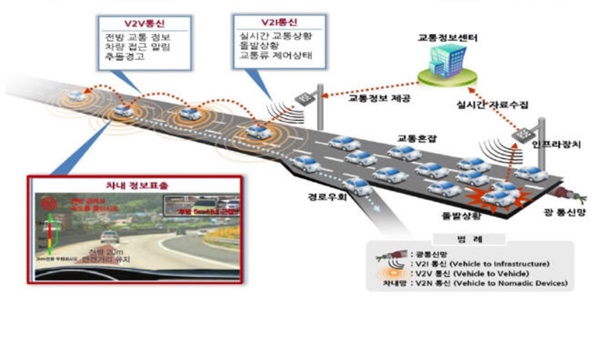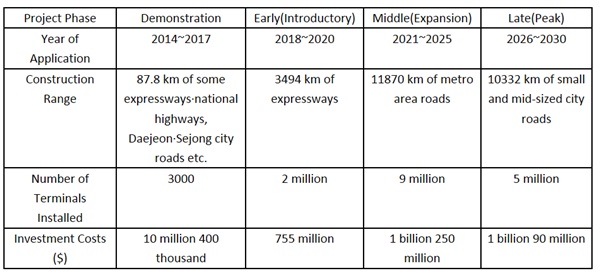Massive Participation of IT Service·Communication·Electronics Companies
The competition to win contracts for the establishing project of the next generation Intelligence Transportation System(ITS), of which the scale is about 3.1 billion dollars, has kicked into high gear. Many enterprises including communication·electronics·IT service·software(SW) companies have plunged into the competition as the first demonstration project is near ahead. Companies attending the demonstration project can take advantageous positions first in winning contracts for the main project.
The Korea Expressway Corporation, which was entrusted the next generation ITS establishing project by the Ministry of Land, Infrastructure and Transport, announced on March 19th that proposal submissions are due April 3rd. Priority bidders will be selected before April 10th.
■6 Consortiums to Participate in Various Examinations
△SK Telecom·LG Electronics △Hyundai AutoEver △Posco ICT △Daebo Communication & Systems △Nongshim NDS △KRTnet Corporation etc. currently compose the consortium. A mass of related equipments and SW business are also included in the consortium. They are all likely to submit proposals, since they are already participating in the performance testing in which road construction is in process.

A consortium official said, “We are preparing very hard, since companies attending the demonstration project are expected to be advantageous in winning contracts for the main project, which will be tendered in mega size.”
The Expressway Corporation is proceeding communication testing and in-situ testing before proposal submissions. Support tests for the exclusive standard of 802.11p for vehicle communication supervised by the Telecommunication Technology Association (TTA) are carried out until the 20th. 802.11p is a technology that enables communication even when the vehicle and device is over 1 km away from each other, with the vehicle running at 100km/h. Companies must pass this test to be qualified for proposal. A Expressway Corporation official said, “As far as I know, all consortiums that participated in the test have passed.”
After the communication testing, there is the in-situ testing which is carried out on actual roads. The core of the in-situ testing, which is carried out until the 27th, is the field application based on the communication performance of the next generation ITS 5.9㎓ physical layer. Expressway Corporation officials explained, “In-situ test results are reflected in the technology assessment scores. They apply for 5 points out of the total score, 80.”

■A 3.1 Billion-Dollar-Scale Follow-Up Project After Demonstrating Project
The next generation ITS is a high-tech transportation infrastructure for sharing real-time risk information among vehicles and the infrastructure, and preventing traffic accidents. 3.1 billion dollars will be invested until 2030.
The demonstration project applies to a total of 87.8㎞, including the Dangjin-Daejeon expressway, Honam line branch expressway, national highway line 1, Daejeon city roads, Sejong city roads, etc. With a scale of 10 million 400 thousand dollars, it will be completed in April, 2017.
Once the demonstration project is finished, the following project will proceed until 2020, applying 2 million terminals to 3494 km of expressways. The business budget is 755 million dollars. Until 2025, 9 million terminals will be applied to 11870 km of metro area roads, and until 2030, 5 million terminals to 10332 km of small and medium-sized city roads. Phased budgets reach up to 1 billion 250 million dollars and 1 billion 90 million dollars.
The Transport Ministry expects an annual cost saving of 712 million dollars as congestion situations are to be reduced by 30~60% once the next generation ITS is introduced. Since highway capacity will increase, the traffic volume will increase by 13% and traffic accident costs will decrease by 3.2 billion dollars. The effect of new market outputs such as the vehicle communication market in 2027 are expected, as well.
Staff Reporter Shin, Hye-kwon| hkshin@etnews.com